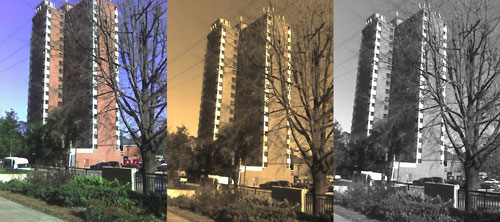 Patience and perseverance limit what you can do with image processing to improve your Treo's pictures. I yanked out the proverbial extra stops for a couple of "after-after" images to demonstrate, even editing the green and blue "channels" to correct localized color casts. I also applied extensive dodging and burning. Some images scream for this extra work - the backlit sky that went acid-trip pink, for example. Notice, however, that the black and white version looked decent without much manipulation.
Patience and perseverance limit what you can do with image processing to improve your Treo's pictures. I yanked out the proverbial extra stops for a couple of "after-after" images to demonstrate, even editing the green and blue "channels" to correct localized color casts. I also applied extensive dodging and burning. Some images scream for this extra work - the backlit sky that went acid-trip pink, for example. Notice, however, that the black and white version looked decent without much manipulation.
Here's what else I did, beyond the items just mentioned.- Apply "Desaturate" using a large brush to the shadow area in the foreground.
- Dodge selected areas with a small brush to bring out detail in darker areas.
- Burn in grass in foreground with a small brush and other areas with large diffused-edge brushes.
- Locally increase saturation on flowers and copper dome with small and tiny brushes.
- Reduce yellow and blue cast in sidewalks and foreground shadow areas by lightening or darkening only the blue channel.
- Bias the Magenta color component in Color Saturation requester and reduce saturation selectively for Magenta.
- Apply 3.4% Gaussian Noise to entire image to hide defects.
Bye-bye blobs
Watch out for including extremely bright "specular" reflections in a picture. These amount to photographing the sun, or at least its image. The Treos' feeble lenses go bonkers trying to resolve such highlights, and the result--well, just eyeball the blue blobs in Harv's palm (tree) picture for a perfect example.
You can fix those blobs in post processing, or at least make them less objectionable. Forget having real detail where the blitz blitzed it, but you can greatly reduce the scare factor.- Open the image in CorelPaint, Paint Shop Pro, Photoshop or other program. Irfanview can't do this, because you need highly localized correction.
- Put the image view at 100% or higher, to see what you're doing.
- Select the "Sponge" tool (or similar in whatever program you use) and adjust the size of its "brush" to half or so of the blue blob's size. Set the tool's mode to "Desaturate," and set it to apply at 50% or less.
- Swipe the blueness with the tool. Feel free to adjust brush size to your comfort level. Your effort must apply the effect only to the spots where the backlighting squonked (technical term) the color.
- If the area is also lightened, as it usually is, run the "Burn In" tool over it to make it match the surrounding areas. If you use a fuzzy-edged brush, burned-in areas will blend nicely with the surrounding image, and your brushstrokes won't have to be too precise.
- Local color correction may also be necessary. Select the area with the "Lasso" tool, feather the selection by several pixels (to spread the edges of the changes you apply), and color-correct the selected area. Keep your mouse finger close to the Undo button. This is an art, not a science.
- For a more adventurous approach, use the burn/dodge tool on the blue "channel" instead of or in addition to these steps. If you know what this is, you probably don't need me to tell you how to do it. So I won't.
Conclusion
A picture can be worth a thousand words, even Treo images. A bad picture rates some words, too, mostly of the four-letter variety. These tricks should give you a much better chance. With skill and care, plus a handy image processing program, you're more likely to get useful images out of the cameras while you wait for beefier, better models to come.

Copyright 1999-2016 TreoCentral. All rights reserved :
Terms of Use : Privacy Policy
TREO and TreoCentral are trademarks or registered trademarks of palm, Inc. in the United States and other countries;
the TreoCentral mark and domain name are used under license from palm, Inc.
The views expressed on this website are solely those of the proprietor, or
contributors to the site, and do not necessarily reflect the views of palm, Inc.
Read Merciful by Casey Adolfsson
 Patience and perseverance limit what you can do with image processing to improve your Treo's pictures. I yanked out the proverbial extra stops for a couple of "after-after" images to demonstrate, even editing the green and blue "channels" to correct localized color casts. I also applied extensive dodging and burning. Some images scream for this extra work - the backlit sky that went acid-trip pink, for example. Notice, however, that the black and white version looked decent without much manipulation.
Patience and perseverance limit what you can do with image processing to improve your Treo's pictures. I yanked out the proverbial extra stops for a couple of "after-after" images to demonstrate, even editing the green and blue "channels" to correct localized color casts. I also applied extensive dodging and burning. Some images scream for this extra work - the backlit sky that went acid-trip pink, for example. Notice, however, that the black and white version looked decent without much manipulation.
